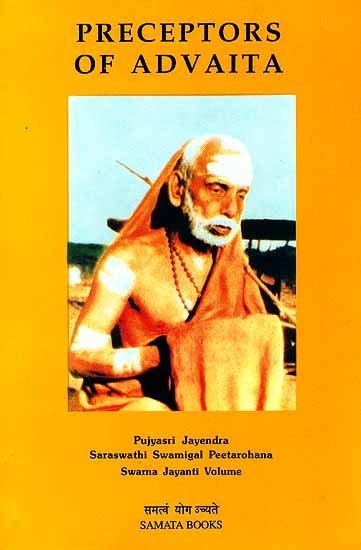Preceptors of Advaita
by T. M. P. Mahadevan | 1968 | 179,170 words | ISBN-13: 9788185208510
The Advaita tradition traces its inspiration to God Himself — as Śrīman-Nārāyaṇa or as Sadā-Śiva. The supreme Lord revealed the wisdom of Advaita to Brahma, the Creator, who in turn imparted it to Vasiṣṭha....
36. Rāmatīrtha
RAMATIRTHA
by
P. V. Sivarama Dikṣitar
Vedānta-viśārada, Vedānta-śiromaṇi
Several are the great geniuses and original thinkers who have put forth earnest effort to spread the philosophy of Advaita, which is the quintessence of the Upaniṣads, the eternal fountains of true knowledge, by their classical and immortal works. Śrī Rāmatīrtha may be ranked with the foremost among the teachers who contributed lucid expositions of and illuminating commentaries on Advaita classics.
In the domain of the Śāstras, it was the custom in the olden days to assess the importance of an author, not so much by the number of works he himself composed, as by the chain of commentaries that subsequent writers thought it necessary to write to bring out the wealth of ideas implicit in the author’s works.
vyākhyānaparaṃparayaiva vikāsaḥ.
The special virtue of great classics is that they not only have their commentaries but also commentaries on the commentaries, which undoubtedly go to show the invaluable gift of the author of the original.
The special features of a commentary (vyākhyāna) are mentioned in the following well-known verse.
padacchedaḥ padārthoktiḥ vigraho vākyayojanā
ākṣepaścha samādhānam etadvyākhyānalakṣaṇam.
As could be seen from this it is no easy task to become a commentator, because, considering the various intricacies of a work, the requirements to be fulfilled by a commentary demand true talent. As a commentator, Śrī Rāmatīrtha fills the bill very well.
We find from the last sentences of all the works of Rāmatīrtha that he was the disciple of Kṛṣṇatīrtha.
kṛṣṇatīrthaśiṣyarāmatīrthakṛte.
Śrī Kṛṣṇatīrtha has been mentioned as his guru.
‘śrīkṛṣṇatīrthagurupādayugam namāmi’.[1]
Another work Vedāntasāraṭīkā also bears evidence to this fact.
vedāntasāravivṛtim rāmatīrthābhidho yatiḥ
chakre śrīkṛṣṇatīrtha śrīpādapaṅkaja ṣaṭpadaḥ.[2]
But in the Pañchīkaraṇa-vivaraṇa-vyākhyā (Tattvachandrikā) it has been stated that Jagannāthāśramī was his guru.
jagannāthāśramā ye guravo ye kṛpālavaḥ.
And in the beginning of the Vedāntasāraṭīkā he says,
vāṇīkāyamanobhiḥ śrīguruvidyāgurūn namaskṛtya
vedāntasāraṭīkām kurve śraddhāvaśāt yathābuddhi.
Thus on the strength of the above references we come to the conclusion that Rāmatīrtha had two gurus, a Śikṣāguru and another Dīkṣāguru.
We may also consider a reference made by him to Viśvaveda’s Siddhāntadīpa. in the Anvayārtha-prakāśikā, a commentary on the Saṃkṣepaśārīraka, namely,
‘siddhāntadīpam purato nidhāya’.
From this, one may draw the conclusion that Śrī Viśvaveda the author of the Siddhāntadīpa was Rāmatīrtha’s sampradāyaguru. Therefore, considering all the above facts we may finally take it that Śrī Kṛṣṇatīrtha was his Dīkṣāguru, Jagannāthāśrama and Viśvaveda being the śikṣāgurus; but there is nothing on record to dispute the conclusion that Kṛṣṇatīrtha was the śikṣāguru while the others were his sampradāyagurus.
(i) Śrī Anantadeva I, father of Āpadeva I, the author of Mīmāṃsā-nyāyaprakāśa, was the disciple of Rāmatīrtha. This can be ascertained from, the sentence
śrutam yat śrīrāmatīrthebhyaḥ sampradāyasamāgatam.
(ii) Śrī Puruṣottama Miśra was also the disciple of Rāmatīrtha. This can be known from the following śloka—
ādareṇa bhagavatparāyaṇam
mūrtimantamiva, bādarāyaṇam
rāmatīrthamiha naumi tam gurum
śradhayā diva ivāgatam gurum.
This śloka is found in the Subodhinī which is a commentary on the Saṃkṣepaśārīraka. Subodhini has been written by Puruṣottama Miśra.
(iii) One Nārāyaṇa-pṛya who was the author of Sneha, a commentary on the Kaivalyadīpikā, has stated that he was the disciple of Rāmatīrtha.
The works of Rāmatīrtha so far published do not give us any clue to the exact period of the commentator. But the unpublished manuscript of his commentary on Mānasollāsa gives the date of the commentary as 1630 Vikrama Era (1574 A.D.)[3] Nṛsiṃhāśrama belonged to the 16th century A.D. Rāmatīrtha was his contemporary. Thus we may come to the conclusion that Rāmatīrtha belonged to the later part of the 15th century and the earlier part of the 16th century. It is quite likely that Madhusūdanasarasvati was a contemporary of Rāmatīrtha. This period, it may be stated, was a bright period in the history of our land as there was a large number of brilliant scholars throughout the country. Rāmatīrtha’s style is lucid and simple. His expressions are forceful and at the same time vividly descriptive. By logical remonstrances he inculcates upon the readers morals of a higher order. His persuasive arguments infuse courage and confidence into them. Not only is his contribution to Advaita philosophy invaluable, but also the manner in which he presents that philosophy is such as to cultivate detachment and discrimination in the reader.
The following are the works ascribed to Rāmatīrtha.
- Commentary on the Upadeśasāhasrī of Śrī Śaṅkara.
- Naiṣkarmyasiddhisārārtha.
- Pañchapādikāvivaraṇa-vyākhyā.
- Pañchīkaraṇa-vivaraṇa-vyākhyā or Tattvachandrikā being a commentary on Ānandagiri’s Pañchīkaraṇa-vivaraṇa.
- Mānosollāsa-vṛttānta-vilāsa being a commentary on the Mānasollāsa of Sureśvarāchārya.
- Vākyārtha-darpaṇam—This work explains the meanings of the mahāvākyas of the various Upaniṣads.
- Vedāntasāra-vyākhyā (also called Vidvanmanorañjinī, a commentary on Sadānanda’s Vedāntasāra.
- śārīrakarahasyārtha-prakāśikā being a Vṛtti on the Brahmasūtra.
- Saṃkṣepaśārīraka-vyākhyā also called Anvayārtha-prakāśikā.
In this work at the beginning as well as at the end we find the following ślokas—
tasyāhamatrarjjupathena samyak padānvayārtham prakaṭīkaromi
siddhāntadīpoktimavekṣya mūla śāstraśrutīrmūlanibandhanamcha.
siddhāntadīpam purato nidhāya vedāntamantargṛhasanniviṣṭam
saṃkṣepaśārīrakaratnapuñjam prakāśamādāya mayā viviktam.sarvajñātmamunipraṇītamamalam samkṣepaśārīrakam dṛṣṭāntarvibhavam puraskṛtamahāsiddhāntadīparchiṣā unnīyārthavibhāgataḥ pratipadam sambandhavidyotinī vyākhyā tasya satām manaḥ pṛyakarī vyākhyatṛchittaukasaḥ
From these verses it is clear that there was a commentary on Saṃkṣepaśārīraka called Siddhāntadīpa. Taking advantage of that commentary Rāmatīrtha declares that he has written this Anvayārtha-prakāśikā.
- Chidānandalaharī—This is mentioned in the commentary of Vedāntasāra.
Rāmātīrtha’s devotion towards Śrī Rāmā is immeasurable. From the following śloka, the style of which is undoubtedly his own, one may observe that Rāmatīrtha viewed the Rāmāyaṇa from a unique philosophical angle.
vidyā sītā viyogakṣubhitanijasukhaḥ śokamohābhipannaḥ
chetassaumitrimitraḥ bhavagahanagataḥ śāstrasugrīvasakhyaḥ,
hatvāste dainyavālim madanajalanidhau dhairyasetum prabadhya
pradhvastābodharakṣaḥ patiradhigatachijjānakiḥ svātmawāmaḥ.
Footnotes and references:
[1]:
See Pañchīkaraṇa-vyākhyā.
[2]:
See Vedāntasāraṭīkā-vidvanmanorañjinī, p. 135 (Nirnayasagar Edn.)
[3]:
See Ms. No. 1120, Royal Asiatic Society, Bombay.
